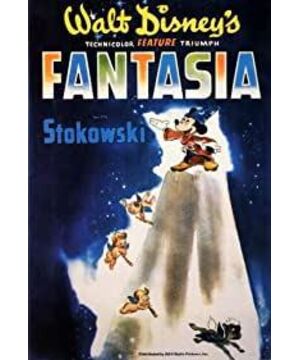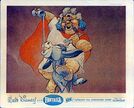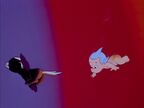In the cartoon "Fantasia", which is full of artistic exploration significance, Disney and his partners spread their fantasy wings and fly on the ocean of classical and modern music. They illustrated eight songs with rich artistic imagination and vivid animation images. Music masterpiece.
The musical works illustrated in "Fantasia" can be divided into three types: pictorial music, narrative music and abstract music.
The first piece of music illustrated in the film is "Toccata and Fugue in D minor" by John Baja. This is a kind of "pure music", created in the early 18th century. It neither paints beautiful pictures nor tells moving stories, but shows various musical techniques and musical forms. Soon after the film began, the unfettered free form of "Toccata and Fugue", accompanied by the ever-changing screen image, brought the audience into a magical realm like a dream. At first we saw the performance of the orchestra and realized the existence of the musicians themselves. But when the melody of "Fuge" sounded, the screen image became more and more abstract and more illusory. In the repetition and development of the musical theme, the animated image of the violin bow is like a flying silver swallow, which flies across the screen; the unique music question-and-answer format of "Fuge" is accompanied by the infiltration and spread of colors on the screen. Madara's dancing and beating. The slender projection of the bass instrument gradually becomes a group of light and shadow, like a group of colored arrow shafts, opening and closing changes. The colorful spectrum flashes on the background of different colors, symbolizing the musical themes of different instruments. Like Baja music itself, the opening of "Fantasia" is dreamlike and poetic. It interprets the music with abstract and beautiful animations. , And interweave the different musical themes in the original work in a strict form of composition.
The second part "The Nutcracker", the original work is based on Tchaikovs' ballet composed for the St. Petersburg Opera House in 1892, and consists of eight fragments. "Fantasia" uses the six fragments behind the original work, namely "Candy Fairy Dance", "Chinese Dance", "Reed Flute Dance", "Arabian Dance", "Russian Dance" and "Hundred Flower Waltz", and put them together. It is a "Nature Ballet Series" with flowers, plants, goldfish and fairies as actors. These animated dances fully demonstrate the beauty and richness of nature, and show the natural characteristics of different seasons through the changes of the four seasons.
The third part "The Magician's Apprentice", the original is a scherzo composed by Paul Dukas for the orchestra in 1897. This piece uses music as a medium to retell this funny story. In this part. Mickey Mouse "starred" as the apprentice of the magician, making the whole film more lively and interesting. After using a spell to make a broom to carry water for him, he lay down on an easy chair and fell asleep, dreaming that he was standing on a cliff, directing the clouds, the stars and all things in the celestial bodies to move according to his own will, and calling the sea under his feet. Roll up ten thousand waves. When the waves splashed on him, he was awakened from his dream and found that the cave had been filled with flood water, and his easy chair was floating on the water. The flustered scene when he flipped through the huge magic book in the whirlpool was also full of wit. In this part, the animation image and the music image are seamless and complement each other. For example, in the end, with the accompaniment of harp music, Mickey Mouse walked six steps on tiptoe. When he took the seventh step and was about to get out of the cave, the magician picked up his broom and beat him. Mickey Mouse sprinted out of the hole, merging with the rapid rhythm of the last four chords of the music.
The following "The Rite of Spring" is a ballet music composed by Stravins in 1912, focusing on the dance and etiquette of Russian tribes in the prehistoric period. The composer himself once said, "The birth of spring in the prehistoric period is the basis for the composition of this work." Disney and his artists visualized this musical work through "space travel", "volcanic eruption", "underwater world", "Jurassic pterodactyl", "dinosaur family", "the weak and strong", and "the great migration". The eight passages including "Cradle of Life" and "Cradle of Life" show the evolutionary process of life on Earth hundreds of millions of years ago from a magical perspective. This film was taken in the early 1940s, when it was fashionable that no one could examine our earth from outer space. But Disney boldly proposed that the mysterious and spectacular scenery in the celestial bodies should be put on the screen as accurately as possible. So we look down on the earth before the birth of mankind from the point of view of outer space. At the beginning of this part, the camera led us from space a few light years away, into the ring nebula, through the Milky Way, through a cloud of haze, accompanied by patches of red nebula and meteors, straight to the earth, Finally arrived at the volcanic crater spraying molten lava. The film also reproduces the life images that have long been extinct with rich imagination, and depicts their survival and reproduction and the magnificent and sad scene of their final extinction in vivid details.
The "intermission" of "Fantasia" is as extraordinary as the film itself. Disney artists were inspired by the soundtracks on film, illustrated several different soundtracks with animation and gave each sound a unique personality. When Taylor introduced the "Voice Cord" to the audience, the "Voice Cord" shyly walked into the middle of the screen. When Taylor finished saying "Every beautiful voice can create a corresponding beautiful picture", the "vocal cords" smiled and returned to the original place. Since then, the film’s animated illustrations of the sound trajectories of several musical instruments not only inspire knowledge, but also give people the enjoyment of art.
In the fifth part, "Pastoral Symphony" is one of the most beautiful passages in the film. The original music was composed by Le Saint Beethoven between 1807 and 1808. The subtitle is "Reminiscences of Country Life". Beethoven also gave a subtitle for each movement. It is from these titles that Disney was inspired to create a vivid and vivid screen image. The first movement of the original work is "Musical Emotions Aroused by Arriving in the Country", and in "Fantasia" it becomes the life scene of the Greek gods at the foot of Olympia. The second movement "Stream Scenery" has become a beautiful love life in this blessed land. The film not only reproduces the beautiful pictures of the clear spring stone in the original work, but also depicts the happy scene of the mythical characters in the stream and the stream. The third movement "Farmers' Carnival" became a carnival of Bacchus. The fourth movement "The Tempest" is displayed by a vivid animated image. When the sky was dim, the god Zeus appeared in the clouds above the drunkard. He took the flashing electric tapes from Valka, the god of blacksmithing, and threw them on the head of Bacchus. People fled around. Finally, the wine tank was crushed and the wine overflowed. When Zeus was tired, he rolled up the clouds, covered him, and fell asleep. The fifth movement, "The Shepherd's Grateful Hymn after the Storm", turned into a beautiful sunset scene in the film. After the storm, the rainbow goddess Elli flew across the sky with a seven-color rainbow belt; Cupid, the god of love, and the Muse, the god of art, frolicking in the clouds; Apollo, the sun god, drives a golden chariot drawn by three majestic horses Passing through the clouds, waved to the revelers on the earth; the god of dreams Maufeus flew from the distant horizon and hung the night in the sky; the goddess of the moon, Diana, lightly grabbed a crescent moon , As if grabbing a silver bow and shooting a comet calmly. The comet became a starry sky. Star Dou falls on their respective positions in the night sky, showing the perfect harmony of celestial bodies and everything.
"Dance to the Gods" is a ballet in the opera "Smiling Man", composed by the composer Amircar Ponceri in 1876 at the Milanska Opera. Poncheri’s original music shows the grand view of ritual dance; "Fantasia" turns it into an animal ballet, using exaggerated imitations to make the elegant actresses and handsome actors in classic ballet comics ridiculous.
The film's ending song "Night of the Barren Mountain" and "Blessed Mary" consist of two parts. The former is based on a concerto composed for piano and orchestra by Mossalls in 1806. The film uses music processed by his friend Limsky Korsakov in 1882. The latter is a famous piece composed by Schubert, whose lyrics were specially composed for "Fantasia" by the poet Richard Feld. The ending treatment of the film is called "a wonderful combination of secular and sacred." In this delicate arrangement, the end of the first piece of music and the beginning of the second piece of music are naturally connected together. The bell that announces dawn in "Night of the Barren Mountain" becomes the bell that calls Christians to pray in "Halloween Mary", uniting the two spaces into a whole.
Although "Fantasia" is composed of the above-mentioned eight different styles of music and corresponding animated images, it is not a piecemeal piece, but a complete "concert feature film". Disney said that music can induce different images and feelings in different people's minds. The starting point of his creation is to hope that the audience can magnanimously regard this film as merely a personal interpretation of great musical works. Among them, there are not only wonderful animation images, but also the successful combination of musical connotation and visual image. The recurring conducting world in the film is specially produced, which not only highlights the skillful skills and chic image of the orchestra conductor, but also acts as the leading motive throughout the film. In the prologue and some passages, it is an actual command arena, and Mickey Mouse once ran forward to shake hands with Strkowski cordially. It is another symbol: at the end of the first paragraph, it dissolves into dark purple undulating mountains under the blue sky; in "The Magician's Apprentice", it becomes a peak again, with Mickey Mouse standing on it waving the stars, Later, it turned into a barren mountain, where the devil made waves and directed the witches to sing and dance and revel; even the Olympia Mountain in the "Pastoral Symphony" also took on the shape of a conducting altar. These examples show that whether it is real or illusory, and whether it is concrete or symbolic, the "conducting circle" is the central image and continuous motivation of Fantasia.
In addition, from the perspective of the overall structure of the film, although each paragraph begins and ends with silence, and there are many similarities; but there are also many excellent speed changes and successful sound and picture combinations, which give the film a high level of viewing. value. As Philip Franz said in the "London Observer" magazine, for "Fantasia", "the most important thing that people feel today is the infinite richness of creativity, high spirits, cleverness, and the smooth and lively animation. ". In short, "Fantasia" has set a monument in the history of the world's animation film development with its originality, distinctive features and technical achievements.
View more about Fantasia reviews










